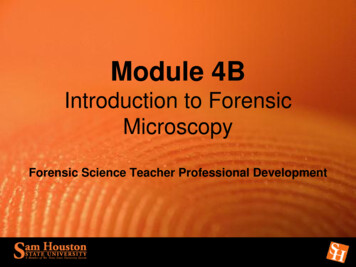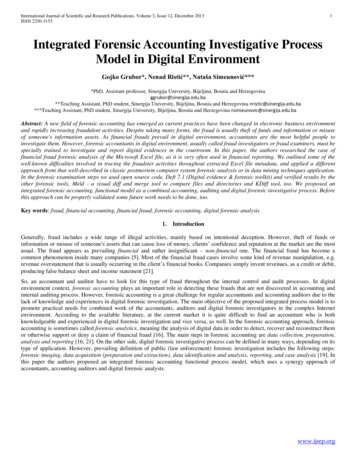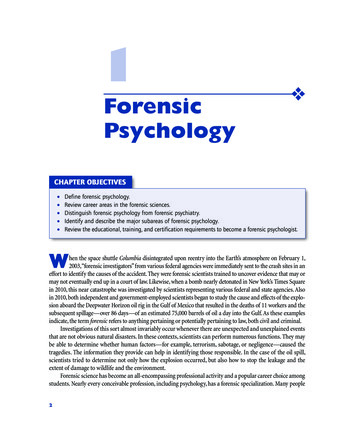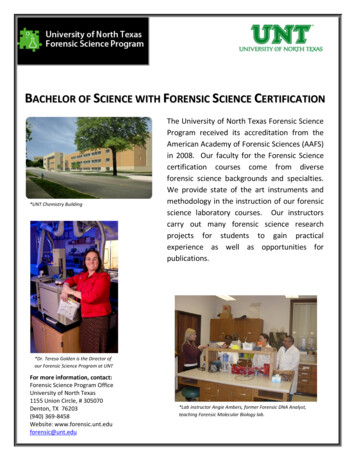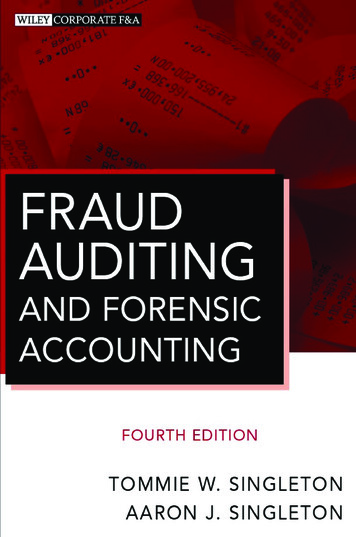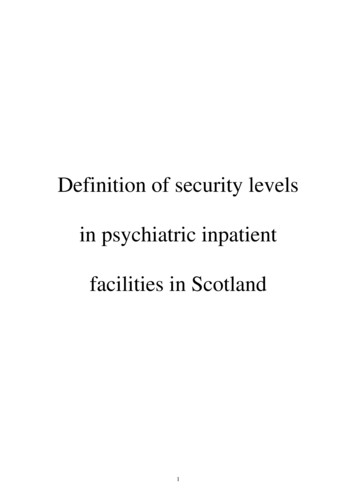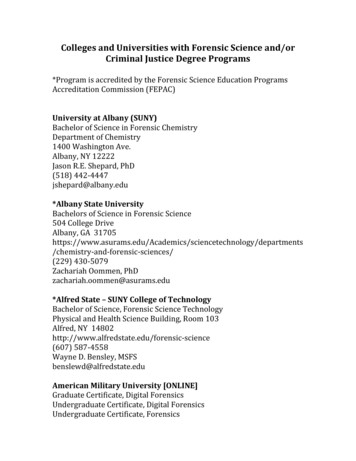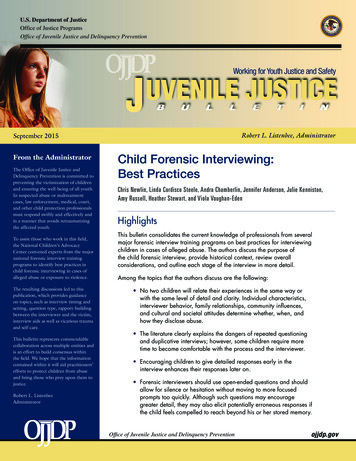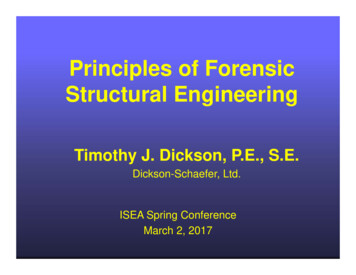
Transcription
Principles of ForensicStructural EngineeringTimothy J. Dickson, P.E., S.E.Dickson-Schaefer, Ltd.ISEA Spring ConferenceMarch 2, 2017
Overview Definition of Forensic Engineering Methodology for ForensicInvestigations Case Studies of Structural Failures How Forensic EngineeringInformation Is Used In Litigation Questions / Discussion
Definition(Source: www.merriam-webster.com)
Who Needs This Service Attorneys Insurance Carriers– Property– Liability Building Owners
Typical Issues Collapse/Failure Analysis Construction Defects– Construction Documents– Building Code Requirements– Industry Standards Design Errors– Standard of Care Storm/Fire Damage Assessment
Historic Failures Hyatt Regency Walkway Collapse(Source: Pfrang and Marshall, 1982)
Historic Failures Ronan Point Apartments(Source: The Daily Telegraph, 1968)
Historic Failures Hartford Civic Center(Source: Connecticut Historical Society)
Methodology for Investigation Visual InspectionRemote Visual InspectionDestructive EvaluationLoad Testing and InstrumentationNon-Destructive TestingMaterial TestingDocument ReviewStructural AnalysisReport Preparation
Visual Inspection Always the first step of aninvestigation Take all steps necessary to preventspoliation of evidence For collapse investigations, use thefinal location of failed members toprovide evidence of the sequence ofevents You can’t take too many photos
Visual Inspection
Remote Visual Inspection Borescope– Rigid or flexible– Good of looking inside walls Sewer cameras– Readily available Unmanned flying vehicle– Drones can be useful, but legal issuescurrently make it very difficult
Remote Visual Inspection
Remote Visual Inspection
Destructive Evaluation Attempt to determine how componentsof the building were constructed All interested parties need to bepresent during destructive evaluation Beneficial to develop a protocol toestablish how the destructiveevaluation will be performed Document any evidence retained andmaintain a “Chain of Custody” log
Destructive Evaluation
Destructive Evaluation
Destructive Evaluation
Destructive Evaluation
Load Testing and Instrumentation ASTM E196 – Standard Practice forGravity Load Testing of Floors andLow Slope Roofs ACI 318 Chapter 20 – StrengthEvaluation of Existing Structures ACI 437.2 – Code Requirements forLoad Testing of Existing ConcreteStructures
Load Testing and Instrumentation Due to high cost, usually a “lastresort” to evaluate structure Must determine how to safely applyload– Hydraulic jacks, water, air bags, etc. Must consider how to maintainstability of structure if failure occurs Strain gages, extensometers,LVDT’s, accelerometers, pressuregages, load cells, etc.
Non-Destructive Testing Pachometers(Photo courtesy of Proceq)(Photo courtesy of Proceq)
Non-Destructive Testing Ground Penetrating Radar(Photo courtesy of Proceq)(Photo courtesy of Proceq)
Non-Destructive Testing Schmidt Hammer(Photo courtesy of Proceq)
Non-Destructive Testing Ultrasonic Pulse Velocity(Photo courtesy of Proceq)
Non-Destructive Testing Thermal Imaging
Non-Destructive Testing Thermal Imaging
Non-Destructive Testing Thermal Imaging
Non-Destructive Testing Thermal Imaging
Non-Destructive Testing 3D High-Density Scanning– Method to accurately document theconfiguration of an accident scene– Point cloud create using laser scanner– Allows for the development of computermodel of the scene
Non-Destructive Testing 3D High-Density Laser Scanning
Material Testing Determine actual material propertiesas opposed to design properties More realistic results if actualmaterial properties are known– Compressive strength– Tensile Strength Petrographic Analysis Metallurgical Analysis
Material Testing
Material Testing Petrographic Analysis– Microscopic Analysis of Concrete
Material Testing Metallurgical Analysis
Document Review Construction DocumentsMaintenance RecordsReports By Other ExpertsComplaint Filed with a CourtIncludes Interviewing PeopleInvolved
Structural Analysis 3D Computer Modelling– Finite Element Analysis More realistic results if actualmaterial properties are known Different approach if trying to provideanalysis for failure rather thaninvestigating a code complianceissue
Report Preparation Know your audienceUse photographs or sketches effectivelyBe concisePresent opinions in an organizedfashion Can be written in first person List references or information used todevelop opinions
Report Preparation Typical Report Sections– Background Information Include the applicable Building Code– Documents Reviewed– Observations– Discussion– Conclusions– Recommendations
How Forensic Information IsUsed In Litigation Examining the Nature of Post-FailureDisputes Presenting Forensic EngineeringInformation as an Expert Witness
Examining the Nature of PostFailure Disputes Putting Parties on Notice– All parties must be given the opportunity toperform their own cause and origininvestigation at the same time Filing of the Complaint– Lawsuit is filed– Notifies defendant of action andopportunity to defend– Lawyers work with Experts to respond
Examining the Nature of PostFailure Disputes Discovery– Cause and origin investigations by allparties at the same time– Various technique by attorney to revealdetails of the claim– Interrogatories– Depositions of parties and experts Experts questioned about details in writtenreport
Examining the Nature of PostFailure Disputes Mediation/Arbitration– Alternate dispute resolution Trial– Rules of Evidence dictates evidence thatwill be admissible at trial
Presenting Forensic EngineeringInformation as an Expert Witness Expert Qualifications– Daubert Standard– “Junk Science”– Established Rule 702
Presenting Forensic EngineeringInformation as an Expert Witness Expert Qualifications– Rule 702 RULE 702. TESTIMONY BY EXPERT WITNESSES A witness who is qualified as an expert by knowledge, skill, experience,training, or education may testify in the form of an opinion or otherwiseif: (a) The expert’s scientific, technical, or other specialized knowledge willhelp the trier of fact to understand the evidence or to determine a factin issue; (b) The testimony is based on sufficient facts or data; (c) The testimony is the product of reliable principles and methods; and (d) The expert has reliably applied the principles and methods to thefacts of the case.
Presenting Forensic EngineeringInformation as an Expert Witness Deposition Testimony– Used to determine the qualifications andopinions of the experts– Occurs during the Discovery phase– Testimony is given under oath Trial Testimony– Expert does not have Attorney/Clientprivilege
Questions/Discussion
Structural Analysis 3D Computer Modelling - Finite Element Analysis More realistic results if actual material properties are known Different approach if trying to provide analysis for failure rather than investigating a code compliance issue. Report Preparation




